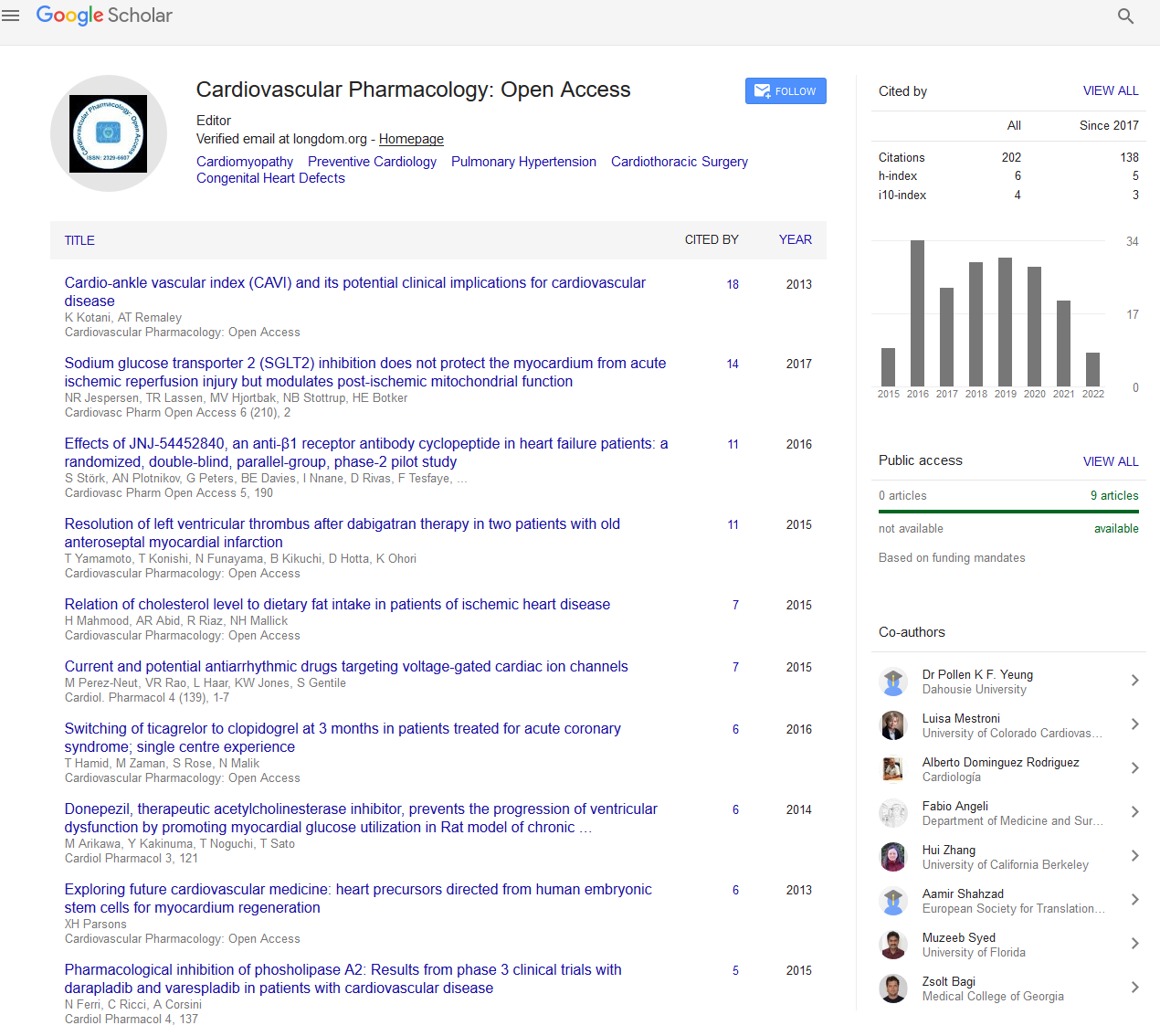Indexed In
- Open J Gate
- Cosmos IF
- RefSeek
- Hamdard University
- EBSCO A-Z
- OCLC- WorldCat
- Publons
- Geneva Foundation for Medical Education and Research
- Euro Pub
- Google Scholar
Useful Links
Share This Page
Journal Flyer

Open Access Journals
- Agri and Aquaculture
- Biochemistry
- Bioinformatics & Systems Biology
- Business & Management
- Chemistry
- Clinical Sciences
- Engineering
- Food & Nutrition
- General Science
- Genetics & Molecular Biology
- Immunology & Microbiology
- Medical Sciences
- Neuroscience & Psychology
- Nursing & Health Care
- Pharmaceutical Sciences
Opinion Article - (2023) Volume 12, Issue 2
Statins: A Lipid-Lowering Medication to Prevent Cardiovascular Diseases (CVDs)
Rand Ayn*Received: 02-Mar-2023, Manuscript No. CPO-23-20548; Editor assigned: 06-Mar-2023, Pre QC No. CPO-23-20548 (PQ); Reviewed: 20-Mar-2023, QC No. CPO-23-20548; Revised: 27-Mar-2023, Manuscript No. CPO-23-20548 (R); Published: 03-Apr-2023, DOI: 10.35248/2329-6607.23.12.339
Description
In terms of global morbidity and death, cardiovascular diseases (CVDs) are the biggest public health issue. About 17.9 million people worldwide die from CVDs each year, or 31% of all fatalities. Due to Atherosclerosis (AS), a long-term inflammatory condition of the coronary artery wall, coronary atherosclerotic heart disease, commonly known as Coronary Heart Disease (CHD), is the main cause of CVDs. As a result of circulatory stenosis or obstruction brought on by AS, the myocardium experiences hypoxia and ischemia, which in turn leads myocardial necrosis and even cardiac mortality. Acute coronary syndrome and stable angina are the two clinical subtypes of Coronary Artery Disease (CHD). It is generally known that CHD is regarded as a common, complicated multifaceted illness that may be strongly correlated with environmental, genetic, and other risk factors, including hypertension, diabetes mellitus, hyperlipidaemia, smoking, and obesity. Controlling CHD risk factors has been shown in numerous studies to significantly lower cardiovascular events in both symptomatic and asymptomatic patients. There is substantial evidence to support the notion that dyslipidaemia is a major factor in the occurrence and death of CHD. The risk of CHD events can be significantly decreased by lowering plasma high cholesterol. Statins, a popular class of lipidlowering medication, are the most extensively prescribed medications in the world since they are the first-line therapy for controlling hyperlipidaemia and CHD risk. The 3-hydroxy-3- methylglutaryl coenzyme A (HMG-CoA) reductase, a controlling enzyme for cholesterol production, is effectively inhibited by statins through competitive inhibition. According to pharmaceutical studies, statins can reduce Total Cholesterol (TC), Low Density Lipoprotein Cholesterol (LDL-C), and raise HDL cholesterol levels (HDL-C). Statins can also stabilize coronary plaques, enhance endothelial function, and reduce the inflammatory response. Statins have been found to have significant secondary preventive effects in individuals with CVDs, according to a large number of recent trials. In patients with CHD, simvastatin can reduce the risk of cardiac and allcause death as well as the recurrence of Myocardial Infarction (MI).
Moreover, study found that rigorous statin medication has an excellent effect on lowering serum cholesterol levels of TC, TG, and LDL-C as well as the risk of significant adverse cardiac events. Even so, angina, nonfatal and/or fatal MI, any coronary heart events, coronary revascularization, and CHD mortality were the key outcomes in this systematic analysis. Any cardiovascular events, CVD deaths, and overall mortality were the secondary endpoints. We also listed the negative side effects, which were primarily cancer, diabetes, gastrointestinal, hepatic, and renal disorders, myalgia, myopathy, rhabdomyolysis, Alanine Aminotransferase (ALT), Aspartate Aminotransferase (AST), and Creative Kinase Elevations (CK). The outcomes for CVD deaths were still debatable, and there were no significant differences in CHD deaths or all-cause mortality between the statin group and control group. According to the pertinent adverse events reported in the studies that were considered, statin medication can lead to diabetes and heighten the risk of renal disease and ALT/AST elevation. Due to the lack of studies or the limited number of studies that monitored patients for less than 3.4 years for various primary and secondary outcomes, including coronary revascularization, CHD deaths, any cardiovascular events, and CVD deaths, we were unable to do the subgroup analysis for these outcomes. The occurrence of angina, nonfatal myocardial infarction, any myocardial infarction, any coronary heart events, and all-cause mortality were thus the subjects of a subgroup analysis. Some patients will discontinue statin medication as a result of these side effects. However, a population study has shown that maintaining statin use after side effects can reduce the frequency of fatal and cardiovascular events.
Hence, statins have more benefits than drawbacks. Two factors could be taken into account to lower unfavorable situations. At the one side, existing studies indicate that lipophilic statins, as opposed to hydrophilic ones, contributed more easily to cytotoxicity, and this association was unrelated to the benefits of cholesterol reduction. In people without clinical evidence of CHD, statins appeared to be helpful for the primary prevention of coronary heart events, although there were no statistical differences between CHD deaths and all-cause mortality.
Citation: Ayn R (2023) Statins: A Lipid-Lowering Medication to Prevent Cardiovascular Diseases (CVDs). Cardiovasc Pharm. 12:339.
Copyright: © 2023 Ayn R. This is an open access article distributed under the terms of the Creative Commons Attribution License, which permits unrestricted use, distribution, and reproduction in any medium, provided the original author and source are credited.


